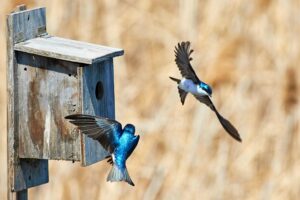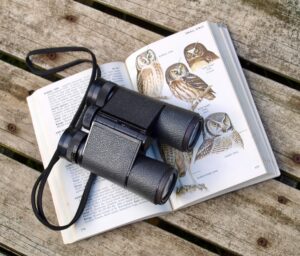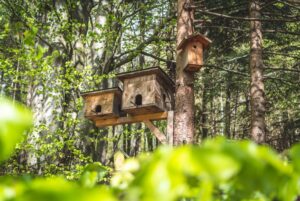Throughout 2020 and 2021, social distancing considerably limited our options for entertainment and hobbies. Sheltering-in-place has definitely expanded our appreciation for nature and creative pastimes. It’s no surprise that many people have turned to backyard birding as a free way to relax, get fresh air, and add enjoyment to their days.
Backyard birding is an activity suitable for people of all ages and physical abilities. It is also completely free and can be done anywhere. All you need to do is go outside with the intention of watching the birds. You don’t even need a backyard — a simple window bird feeder is a great way to attract birds into view for you to enjoy.
completely free and can be done anywhere. All you need to do is go outside with the intention of watching the birds. You don’t even need a backyard — a simple window bird feeder is a great way to attract birds into view for you to enjoy.
With some time, a guide book, and a method of tracking, such as a simple notebook, you can get acquainted with the unique characteristics and habits of your local wildlife all year round, and even help local conservation efforts!
Birdwatching 101: Beginning Your Backyard Birding Adventure
Before you begin your new adventures in backyard birdwatching, it’s important to remember thatbirdwatching is wildlife appreciation. While this hobby should be fun, it is even more important that it is a pastime based on the conservation of the species. Bird watching should never cause harm or stress to the birds, even in your own backyard. Structures such as decks, gazebos, and porches offer you a perch to observe without disrupting the birds.
Staying still and quiet will also keep the birds calm and relaxed, making it more likely that they will get close to you. Another technique for blending in is to wear camouflage or muted colors — never white — while you are birding.
Birders should always give back more than they take and never leave traces of their presence where they are birdwatching. Reviewing the American Birding Association Code of Ethics is a great place to learn more. Another great way to participate in the active conservation of birds and other wildlife species is to record your sightings in citizen science apps such as iNaturalist or eBird, to help guide future conservation efforts!
Use a Field Guide to Identify Your New Feathered Friends
Part of the fun and excitement of birding is identifying the birds you are watching. Ornithology, the study of birds, involves observing characteristics of the bird as well as the habitat in order to identify them.
Depending on where you live, you may see up to 200 species of birds in your back yard. Keeping track of what bird you see and when you see it will help you be more in tune with nature and the world around you.
A field guide helps you identify the birds in your back yard. You can use a book that is custom written for the area you live in, with birds and details specific to your region, or use an app. An app may provide helpful extra features such as AI recognitions from a photograph of the bird, samples of the bird’s calls and songs, and records of sightings from other watchers in your area. Audubon.org, Sibleyguides.com, and Merlin.allaboutbirds.org are popular online field guide apps that have a multitude of resources for learning about bird behavior, habitat, and conservation all in one place.
Keep Records of The Birds You Are Watching
Once you identify the bird, it’s important to take notes. By noting the birds you see, when you see them, and their behaviors, you can begin to anticipate migrations or other patterns. Some serious birders keep a list of the birds they have identified over their entire lifetime.
Spotting a bird can happen at any time, so be ready to record what you see. The more birding you do, the more you’ll become tuned in to your surroundings. Simply by practicing birdwatching, you may begin to see things you never noticed before.
The two challenges of birding are: staying patient and quiet enough to see the bird and properly identifying the species. Because of this, birdwatching is a long game that requires time, concentration, and mindfulness.
Birdwatching is not competitive — there is no race to acquire the biggest list of birds. The fun of getting to know your feathered friends is noticing how they are behaving or singing, how that changes over the seasons, and when they come and go from your backyard.
Gearing Up for Birdwatching
We have already established that you do not need any special gear for a satisfying adventure in birding. But it is much more fun when you can see the action up close with binoculars.
Binoculars are easy to bring along with you and give you an up-close and personal look at the birds you’re searching for. Binoculars help you enjoy the beauty of nature while keeping your distance and letting it do its thing.
you’re searching for. Binoculars help you enjoy the beauty of nature while keeping your distance and letting it do its thing.
Like anything else, binoculars range in price and function. The power, field of view, and focus will vary depending on the quality of the binoculars. It’s important that the binoculars are comfortable, easy to hold onto, and that they fit the user’s needs in every way. It’s helpful if you can test them out before buying them. The Audubon Binocular Guide is a great resource for selecting the perfect pair of binoculars, and locally in Saskatoon, you can check out Don’s Photo Ltd. to help you find the right gear!
How to Attract More Birds into Your Backyard
One of the best ways to attract native birds to your backyard is to have lots of local native plants and insects available. It makes sense that birds would feel more at home and drawn to the natural habitat they were intended to thrive in.
Installing features like birdbaths, bird feeders, and birdhouses are also great for attracting local birds into your backyard. Be aware of the birds in your area before you choose the style of birdhouse and type of birdseed you’re going to use, though. These treats for your neighborhood flocks are not one-size-fits-all — choose the appropriate types for the birds you want to attract.
A specialty garden or nature supply store will offer the appropriate supplies and may have higher quality products than a big-box retailer. Be sure to research how high up you should mount the feeders and houses. Other mounting details to consider: which direction to face and nearby wildlife to avoid
Birdwatching from Home If You Don’t Have a Back Yard
If you don’t have a yard, no problem! You can create a sanctuary from your window that’s appealing for birds to visit. In fact, the higher up you are, the more likely you are to spot migrations of birds of prey like eagles, falcons, and hawks as they pass over your city.
If you are a little closer to the ground, installing a window feeder or a bird feeder on your balcony could make a pleasant pit stop for the birds in your neighborhood.
How to Build Your Own Birdhouse
You could buy a birdhouse, of course, but building one for yourself isn’t just rewarding — it’s also fun! You can customize it for your space and for your visitors.
The first things you will want to assess are the type of birds you’re making a house for and where you want to install the birdhouse. The type of bird you are housing will determine the style of the house and dictate where you can install it. How large the house is, how big the holes are for entering the house, the depth and height of it, and the material it’s made from are all very important things to consider in order to attract the right bird.
Once you know this information, you can choose the most appropriate place to mount, such as hanging or fixed from a pole or tree. Be sure to consider how the elements will impact the placement of the birdhouse.
Choosing a Free DIY Bird House Plan
If you know the type of bird you want to attract and what style of house you need to build, all that’s left to do is decide what you want to build it out of and how elaborate you want it to be.
You can build a fine birdhouse out of recycled materials, like a shoe tree feeder or a teacup, and have a unique feature in your backyard oasis. This is a fantastic activity to do with kids — upcycling old items and creating creature homes is a quality afternoon together filled with lessons that will last a lifetime.
Here is a list of 29 free DIY birdhouse blueprints from quirky to quick-up that gives you a great start for creating the birdhouse of your dreams from scratch for a personalized bird town in your own back yard.
Birdhouse Maintenance
Did you know that some species of birds can suffer from Pink Eye? Also known as conjunctivitis, this disease can be an extremely big problem for our feathered friends who share bird feeders and bird houses. Birds infected with this disease often have red, swollen, runny, or crusty eyes, and in extreme cases, the disease can even cause them to become blind, unable to avoid their predators, and more likely to have fatal window collisions.
We can help birds avoid conjunctivitis and stop the spread by washing our bird feeders, bird houses, and bird baths with a diluted bleach solution (1 cup bleach to 9 cups water) once a week and letting the feeder, birdhouse, or bird bath air dry completely before replacing.
Birds Populations are Plummeting
As we are enjoying watching the birds and learning all about them, it is important to recognize that birds are declining across North America and can definitely use our help. Bird populations have plummeted in the past 50 years, dropping by nearly three billion across North America!
Did you know that predation by domestic cats is the number one direct, human caused threat to birds in Canada? It is estimated that cats kill between 100 and 350 million birds per year in Canada! We can help our feathered friends out by keeping our cats indoors.
Another way we can also help birds is by preventing them from hitting our windows. Birds have no concept of glass and with windows everywhere, reflective glass can be deadly. One solution is a product we use at Beaver Creek Conservation Area called feather friendly. Pick some up today over at Wild Birds Unlimited!
A couple other important things you can do to help out our feathered friends are to avoid using pesticide and herbicides, which are harmful to birds.
Birdwatching is a Hobby for a Lifetime of Enjoying Nature
Learning about the world around you is something you do throughout your entire life. Slowing down and noticing the natural world should be a daily practice. Birdwatching can be enjoyed anywhere, at any time — you don’t even have to go outside. It’s a free hobby that anyone can take part in. Stay safe, de-stress, and learn more about your ecosystem at home with an adventure in birding today.
Original blog posted here on Porch.com. Thank you to Hermann Samano, who submitted and wrote most of this blog.




